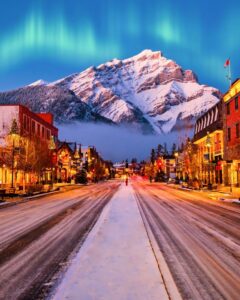Exploring the vast wilderness of Canada is an adventure like no other, and what better way to immerse ourselves in its natural beauty than by hitting some of the most majestic hiking trails Canada has to offer? From the rugged shorelines of the West Coast Trail in British Columbia to the incredible alpine views along the Great Divide Trail, we have the opportunity to witness a variety of landscapes that are as diverse as they are stunning.

Our passion for outdoor activities unites us, and there’s a trail for every one of us, whether we’re looking for a serene walk through a forest canopy or the challenge of scaling rugged mountain peaks. Imagine walking along Kinney Lake & Berg Lake Trails, where the beauty of British Columbia unfolds before our eyes, offering both easy and scenic routes suitable for many of us, regardless of our hiking experience.
Top Destinations for Hiking in Canada

We’re spoilt for choice when it comes to hiking trails in Canada, each promising its own unique blend of awe-inspiring landscapes and rewarding treks.
- West Coast Trail, British Columbia: For a challenging yet striking coastal experience, the West Coast Trail offers a mix of beautiful beaches and lush forest scenery.
- Kinney Lake & Berg Lake Trails, British Columbia: For breathtaking scenery that’s accessible to hikers of all levels, the Kinney Lake & Berg Lake Trails should top your list.
- Iceline Trail, Yoho National Park: The Iceline Trail is perfect for those who want to be surrounded by glaciers and waterfalls.
- Fundy Footpath, New Brunswick: If seascapes are what you seek, the rugged and remote Fundy Footpath is our pick for you.
- Galloping Goose Regional Trail, Vancouver Island: For a more laid-back adventure suitable for biking and horse riding too, don’t miss the historic Galloping Goose Regional Trail.
Each of these destinations showcases the diversity and natural beauty we’re proud to have in our backyard. So, lace up your boots, and let’s hit these trails to experience the vast expanses of Canada’s wilds firsthand!
Planning Your Hike

We’re excited to share essential tips for preparing your adventure on hiking trails in Canada—a land of breathtaking landscapes and trails for every skill level. Let’s dive into choosing the right path, packing effectively, and staying safe.
Choosing the Right Trail
When selecting a hike, consider the length, difficulty, and the scenery you want to experience. For mesmerizing views, the Kinney Lake & Berg Lake Trails in British Columbia offer an easy yet stunning adventure in Mount Robson Provincial Park. If you’re seeking variety, head over to AllTrails to find a trail that matches your experience and fitness level.
What to Pack
Before hitting the trails, ensure you have:
- Navigation tools: map, compass, GPS
- Water and snacks
- Weather-appropriate clothing: layers that can be added or removed
- Safety gear: first-aid kit, multi-tool, headlamp, and sun protection
- For backcountry trips, extra items like a tent and a sleeping bag may be required.
Check the Parks Canada guide to prepare adequately and avoid forgetting essentials.
Safety Tips and Regulations
Your safety is paramount. Always:
- Check weather conditions and trail advisories before departure.
- Inform someone about your itinerary.
- Hike with a buddy when possible.
- Adhere to the Leave No Trace principles to preserve the natural beauty.
Also, be aware of the regional regulations and ensure you follow any park-specific rules or permit requirements. By doing so, we ensure our experiences on hiking trails in Canada are not only memorable but also respectful and safe.
Seasonal Hiking Guide

Exploring hiking trails Canada reveals a diverse tapestry of landscapes, and there’s no better way to connect with nature than by checking the best trails each season has to offer. We’re here to guide you as nature dons its seasonal coats!
Best Trails by Season
- Spring:
- As the snow melts and the flowers start blooming, trails like the Kinney Lake & Berg Lake Trails in British Columbia beckon with their serene beauty. These trails are known for their easy accessibility and stunning lake views, making them perfect for a rejuvenating spring hike. For full details on the terrain, visit this Lonely Planet guide.
- Summer:
- When the sun is shining and the days are longest, it’s the prime time to hit the trails in Banff National Park. This park offers over 1,600 kilometers of maintained trails appealing to all skill levels, from scenic day hikes to more challenging mountain treks. Summer is the best time to soak up the vibrant energy on these paths. Find your perfect trail on Parks Canada’s Banff National Park site.
- Autumn:
- Witness the leaves changing in spectacular fashion by heading to Georgian Bay Islands National Park. With an average rating of 4.5 stars from hikers, these trails are a photographer’s dream as the golden hues of fall provide a stunning backdrop for leisurely walks or more strenuous adventures. Hike through Canadian fall foliage with guidance from AllTrails.
- Winter:
- Don’t be deterred by the cold, as winter hiking can be a magical experience, especially along the trails in Yoho National Park. With 96 hiking trails to choose from, you can enjoy serene snow-laden forests and majestic frozen waterfalls. Ensure to check trail conditions beforehand as some areas may be prone to avalanches. Embrace the chilly splendor with insights from Mountain IQ.
Eco-Friendly Hiking Practice

We’re fortunate to have access to some of the most picturesque and diverse hiking trails Canada offers. Protecting these natural treasures is crucial, so let’s talk about eco-friendly hiking practices.
Stay on Designated Trails
It’s vital that we stick to marked paths to prevent soil erosion and protect plant life.
- Pack it in, Pack it Out:
- Keep our forests and streams clean.
- Carry all trash out with us.
- Leave No Trace:
- Preserve the beauty of nature.
- Leave rocks, plants, and historical artifacts as is.
Use Eco-Friendly Products
In our backpacks should be eco-friendly sunscreen and insect repellent, ensuring that we’re not introducing harmful chemicals into the ecosystem.
Fire Safety
If we must light a fire, it’s our responsibility to:
- Use existing fire rings.
- Keep fires small.
- Make sure the fire is completely extinguished before leaving.
Respect Wildlife
We should observe from a distance and avoid feeding wild animals to maintain the natural balance.
Eco-conscious Campsites
When setting up camp:
- Choose sites that are at least 200 feet from water sources.
- Use previously impacted spots to minimize damage.
Water Sources
We should:
- Use biodegradable soap sparingly.
- Avoid contaminating streams and lakes.
Remember, our approach to multi-day backpacking trips, day hikes, or even a quick trek not only enriches our experience but ensures that these magnificent hiking trails across Canada remain pristine for generations to come.
Joining Hiking Groups and Communities

We are fortunate in Canada to have an extensive network of hiking trails that crisscross our diverse and beautiful landscapes. For those of us looking to connect with fellow enthusiasts and explore these trails, joining a hiking group or community can be the perfect step.
- Meeting Like-Minded Adventurers Joining a hiking group allows us to meet others who share our passion for the outdoors. Whether we’re beginners or seasoned hikers, there’s a club for every level.
- Learning Opportunities With organized groups, we often have access to hiking training programs which can be crucial for safely enjoying the trails.
Here’s how to get started:
- Identify Local Clubs Research clubs in your area. For instance, the Bruce Trail Conservancy operates through different clubs across Ontario, offering a range of group hikes and educational programs.
- Understand Membership Benefits Benefits often include insurance and trail maintenance support. Check out what’s included with your membership by visiting sites like Hike Ontario.
- Consider Your Interests Look for a club that aligns with your interests. The Durham Outdoors Club, for example, offers a variety of activities beyond hiking.
- Engage with the Community Once you’ve joined, participate in meetings, hikes, and events. It’s a great way to deepen your connection to the trails and those who love them.
By immersing ourselves in the camaraderie of a hiking group, we not only improve our own experience on hiking trails in Canada but also contribute to the broader community cherishing our natural heritage.
If you liked this blog post about best hiking in Canada, don’t forget to leave us a comment down below to tell us about your experience with it.
FAQ – Hiking Trails Canada
What is the most famous hiking trail in Canada?
The West Coast Trail, British Columbia. Known as one of the best multi-day hikes in Canada, the iconic West Coast Trail is a must for any avid hiker.
What is the longest hiking trail in Canada?
The world’s longest trail is actually further north though, in Canada. The Great Trail, formerly known as the Trans Canada Trail, runs for a rather daunting 14,912 miles (or 24,000km) and is currently the longest hiking trail in the world.
What is the most difficult hiking trail in Canada?
Canol Heritage Trail, N.W.T.: You’ll need at least 20 days to complete this grueling and massive trail. It stretches 355 km’s from the Yukon-Northwest border to Norman Wells. You should go because it is one of the most remote and wilderness-filled experiences that Canada has to offer you.





